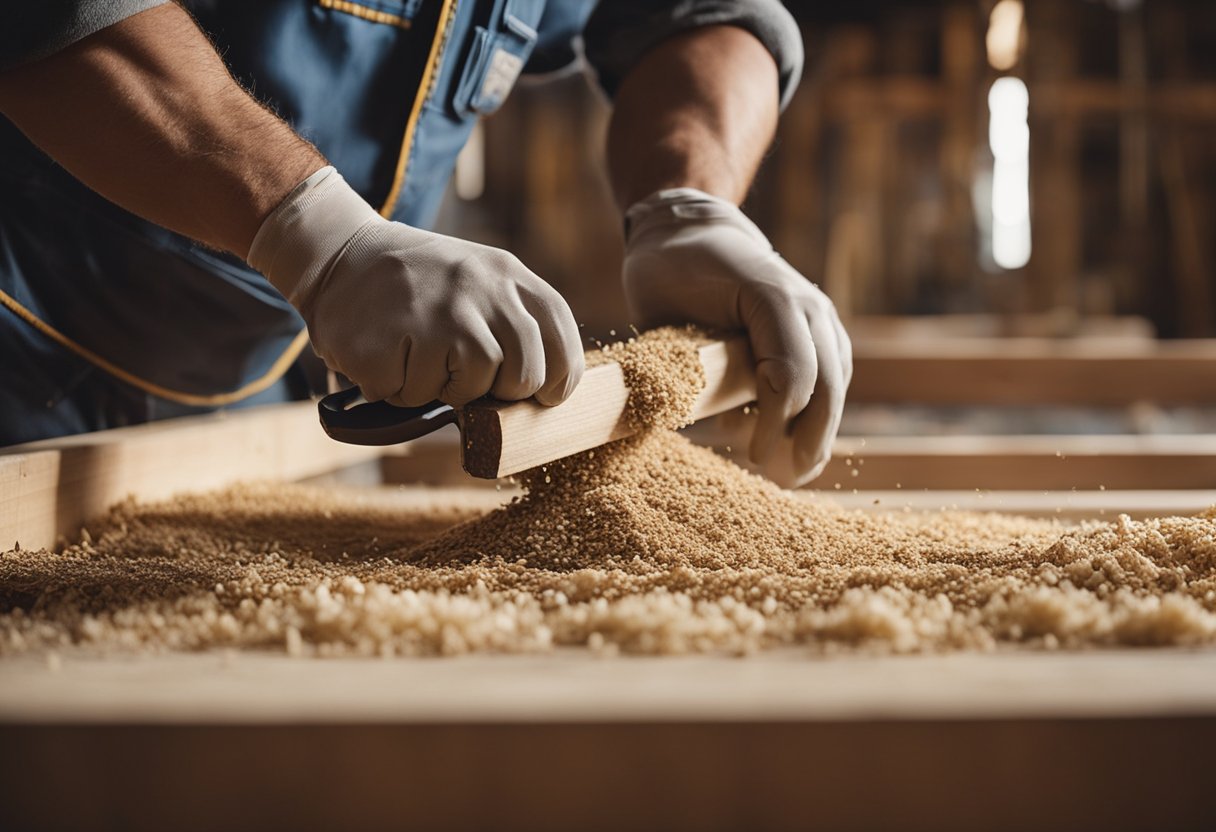Making a 24 foot beam can be a daunting task, but with the right tools and knowledge, it can be done. Beams are an essential part of any building structure and are used to support the weight of the roof, floors, and walls. In this article, I will guide you through the process of making a 24 foot beam and provide you with the necessary information to ensure that your beam is strong, safe, and durable.

Understanding beams is the first step in making a 24 foot beam. Beams are horizontal structural elements that support vertical loads. They are typically made of wood, steel, or concrete and are used to distribute the weight of the structure evenly across the foundation. The size and strength of the beam depend on the load it will be supporting, the span of the beam, and the material used. In the next section, we will discuss beam dimensions and load factors to help you determine the size and strength of your beam.
Key Takeaways
- Understanding beams is essential before making a 24 foot beam.
- Beam dimensions and load factors depend on the load it will be supporting, the span of the beam, and the material used.
- Choosing the right material and consulting with professionals can ensure the safety and durability of your beam.
Understanding Beams
As someone who has made 24-foot beams before, I can tell you that understanding beams is crucial to the process. A beam is a structural element that is used to support loads and span distances. Beams can be made from a variety of materials, including lumber, steel, and engineered lumber.
When it comes to making a 24-foot beam, lumber is a common material choice. Lumber beams can be made from solid wood beams or engineered lumber. Solid wood beams are made from a single piece of lumber, while engineered lumber is made from multiple pieces of lumber that are glued together. The advantage of engineered lumber is that it can be stronger and more stable than solid wood beams.
The strength of a beam depends on its size, species, and grade. The size of a wood beam is typically denoted by its nominal size, which is based on the beam’s width and depth in inches. For example, a 4×6 beam is 4 inches wide and 6 inches deep. The species of wood used in the beam can also affect its strength. Some species of wood are stronger than others, and some are more resistant to decay and insects.
When making a 24-foot beam, it’s important to choose the right size and species of wood. The size of the beam will depend on the load it needs to support and the span it needs to cover. A larger beam will be stronger than a smaller beam, but it will also be heavier and more difficult to handle.
In conclusion, understanding beams is crucial when making a 24-foot beam. The size, species, and grade of the wood used in the beam will affect its strength and durability. By choosing the right materials and size, you can ensure that your beam will be strong enough to support the load it needs to carry.
Beam Dimensions and Load Factors
As I set out to make a 24 foot beam, I needed to take into account various factors such as span, load, and support. The beam I was making needed to be able to support the weight of the structure it was going to be used in, as well as any live loads such as people or furniture.
To start, I needed to determine the span of the beam. The span is the distance between the supports that the beam will be resting on. In this case, the span was 24 feet. This information is important because it will help me determine the size of the beam I need to use.
Next, I needed to consider the load factors. There are two types of loads to consider: dead load and live load. Dead load is the weight of the structure itself, while live load is the weight of anything that will be placed on the structure such as people or furniture. In addition to these loads, I also needed to consider any roof or floor loads that would be placed on the beam.
When it comes to choosing the right beam for the job, it is important to consider the type of beam that will be used. In this case, I decided to use a laminated veneer lumber (LVL) beam. LVL beams are a popular choice for load-bearing structures because they are strong and lightweight.
To determine the size of the beam needed, I consulted span tables and performed mathematical calculations to determine the beam span, forces, bending moment, and deflection. I also needed to consider the depth of the beam, shear forces, and self-load.
In conclusion, when making a 24 foot beam, it is important to consider the span, load factors, and type of beam that will be used. By taking into account all of these factors, I was able to determine the appropriate size and dimensions of the beam needed for my load-bearing structure.
Choosing the Right Material
When it comes to making a 24-foot beam, choosing the right material is crucial. The material you choose will determine the strength and durability of the beam. There are several materials available in the market, including wood, steel, and engineered lumber.
Wood beams are a popular choice for residential construction. They are affordable, readily available, and easy to work with. However, not all wood beams are created equal. The grade and species of the wood will affect its strength and durability. For a 24-foot span, a wood beam made from Douglas fir is a good choice. It is a strong and durable species that is commonly used in construction.
If you are looking for a material that is even stronger than wood, steel beams are a great option. They are incredibly strong and can support heavy loads. However, they are also more expensive than wood beams and require specialized tools and equipment to work with.
Another option is engineered lumber, which is made by bonding together wood fibers and resins. This material is stronger and more stable than traditional wood beams, making it a good choice for long spans. However, it is also more expensive than wood beams.
In summary, choosing the right material for your 24-foot beam depends on your budget and the load-bearing capacity required. Wood beams made from Douglas fir are a good choice for most residential construction projects, while steel beams are ideal for heavy-duty applications. Engineered lumber is a good option if you want a material that is stronger and more stable than traditional wood beams.
Beam Construction and Installation
When it comes to constructing a 24 foot beam, there are a few key things to keep in mind. First, it’s important to choose the right size beam for your project. This will depend on factors such as the weight the beam will need to support and the length of the span. Consulting with a structural engineer can help ensure you choose the right size beam for your needs.
Once you have your beam size determined, you’ll need to construct the beam itself. This can be done using laminate or by joining multiple pieces of lumber together. If you’re using laminate, be sure to use a high-quality adhesive and follow the manufacturer’s instructions carefully.
When joining multiple pieces of lumber together, it’s important to use the right type of joint. Common types of joints include butt joints, lap joints, and scarf joints. Each type of joint has its own strengths and weaknesses, so be sure to choose the right one for your project.
To secure the joint, you’ll need to use bolts or nails. Carriage bolts are a popular choice for beam construction, as they provide a strong, secure connection. Be sure to pre-drill the holes for the bolts to prevent splitting.
To help ensure the beam stays straight and level, you may want to use plywood spacers. These can be placed between the pieces of lumber to help keep them aligned during construction.
Finally, when it comes time to install the beam, be sure to use the right type of post or column to support it. The post or column should be able to handle the weight of the beam and be securely anchored to the foundation.
By following these tips, you can construct and install a 24 foot beam that will provide strong, reliable support for your project.
Consulting with Professionals
When it comes to building a 24-foot beam, it is always best to consult with professionals such as engineers or architects. These professionals have the expertise and knowledge to help you determine the best materials and design for your project.
An engineer can help you with the structural design and calculations needed to ensure that your beam can safely support the weight that it will be carrying. They can also help you determine the right size and type of materials to use for your beam, such as steel or wood.
An architect can help you with the design and aesthetics of your beam. They can help you choose a design that fits the overall look and feel of your project, as well as ensure that the beam meets any building codes or regulations.
When consulting with professionals, it’s important to provide them with all the necessary information about your project, including the size and weight requirements of the beam, the materials you plan to use, and any other relevant details. This will help them provide you with the best possible advice and recommendations.
Overall, consulting with professionals can help ensure that your beam is safe, structurally sound, and meets all the necessary requirements for your project. So if you’re planning to build a 24-foot beam, it’s always a good idea to seek the advice of an engineer or architect.
Purchasing and Costs

When it comes to purchasing materials for a 24 foot beam, there are a few things to consider. First, you will need to decide on the type of material you want to use. Laminated veneer lumber (LVL) and steel beams are common choices for load-bearing structures.
If you decide to go with an LVL beam, you can purchase it from a supplier such as Menards, which offers a 5-1/4″ x 13-3/4″ x 24′ glulam beam for $599.39. Keep in mind that the cost of an LVL beam can vary depending on the size and length of the beam you need.
On the other hand, if you decide to use a steel beam, the cost can be more expensive. According to HomeGuide, the cost to install a steel beam can range from $100 to $400 per foot, with an average cost of $1,200 to $4,200 for residential construction.
It’s important to keep in mind that the cost of the beam is just one aspect of the overall cost of the project. You will also need to factor in the cost of any additional materials, such as bolts and connectors, as well as the cost of labor if you are hiring a professional to install the beam.
Overall, the cost of making a 24 foot beam can be expensive, but it’s important to invest in high-quality materials to ensure the safety and stability of your structure.
Ensuring Safety and Durability

As I build my 24-foot beam, I want to ensure that it is both safe and durable. There are several factors that I need to consider to achieve this goal.
One important factor is the reinforcement steel that I use. I will make sure to use enough steel to provide adequate support and prevent bending stress. I will also ensure that the steel is properly placed and secured to prevent any potential safety hazards.
Another consideration is the stiffness of the beam. I will make sure that the beam is stiff enough to prevent any excessive deflection or sagging. This will help ensure that the beam can support the weight it needs to without any issues.
Staggering the joints of the beam is also important for ensuring its durability. By staggering the joints, I can prevent any weak points in the beam and ensure that it can support the load it needs to.
I will also need to consider any door openings or other obstacles that the beam may need to pass through. I will make sure to properly measure and plan for these obstacles to ensure that the beam can be installed safely and without any issues.
Fastening the beam securely is also crucial for ensuring its safety and durability. I will make sure to use high-quality fasteners that are appropriate for the size and weight of the beam.
Finally, I will make sure to properly cup the beam to prevent any potential warping or twisting. This will help ensure that the beam remains straight and stable over time.
By considering all of these factors and taking the necessary precautions, I can ensure that my 24-foot beam is both safe and durable.
Frequently Asked Questions

What size I beam is needed to span 24 feet?
The size of the I-beam required to span 24 feet depends on several factors, including the load it will bear, the distance between the supporting columns, and the spacing of the beams. A structural engineer can help determine the appropriate size and type of I-beam for your specific project.
How long can a structural beam span without support?
The maximum span for a structural beam without support depends on several factors, including the type of beam, the load it will bear, and the spacing of the supporting columns. A structural engineer can help determine the maximum span for your specific project.
What size LVL beam is required for a 24 foot span?
The size of the LVL beam required to span 24 feet depends on several factors, including the load it will bear, the spacing of the supporting columns, and the spacing of the beams. A structural engineer can help determine the appropriate size and type of LVL beam for your specific project.
What is a flitch beam and can it be used for a 24 foot span?
A flitch beam is a composite beam made of wood and steel plates. It can be used for a 24 foot span, but the size and type of flitch beam required depends on several factors, including the load it will bear, the spacing of the supporting columns, and the spacing of the beams. A structural engineer can help determine the appropriate size and type of flitch beam for your specific project.
Is it possible to make a 24 foot beam using 2x6s?
It is possible to make a 24 foot beam using 2x6s, but the size and number of 2x6s required depends on several factors, including the load it will bear, the spacing of the supporting columns, and the spacing of the beams. A structural engineer can help determine the appropriate size and number of 2x6s for your specific project.
What size ridge beam is needed to span 24 feet?
The size of the ridge beam required to span 24 feet depends on several factors, including the load it will bear, the spacing of the supporting columns, and the spacing of the beams. A structural engineer can help determine the appropriate size and type of ridge beam for your specific project.

Hi, I’m Sal Muller of Tooltrip.com. My DIY experience led me to understand essential power tools for home projects. Tooltrip.com guides enthusiasts and professionals in choosing right tools for any job. I provide concise top tool reviews for easier, efficient DIY.

